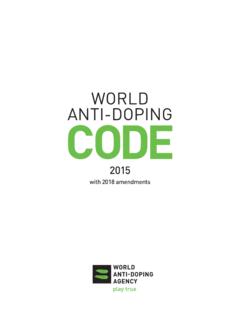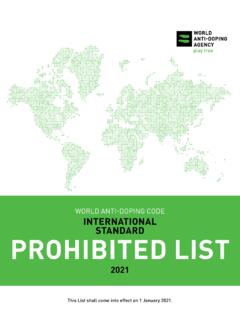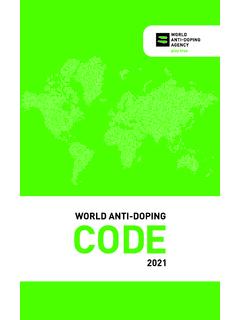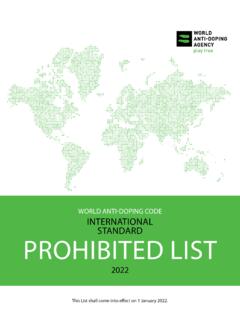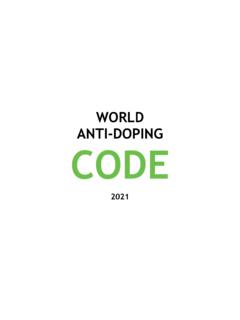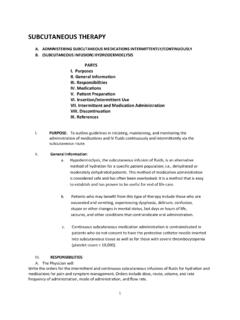Transcription of Intravenous Infusions and/or Injections
1 TUE Physician Guidelines Medical Information to Support the Decisions of TUECs Intravenous Infusions WADA World Anti-Doping Program Version January 2018 1 This Guideline is reviewed annually to determine whether revisions to the Prohibited List or new medical practices or standards warrant revisions to the document. If no changes are deemed warranted in the course of this annual review, the existing version remains in force. Intravenous Infusions and/or Injections 1. Introduction Intravenous (IV) Infusions have been included on the WADA List of Prohibited Substances and Methods under section M2. Prohibited Methods; Chemical and Physical Manipulation since 20051. An IV infusion or injection is the supply of fluid and/or prescribed medication by drip or push directly into a vein. Intravenous Infusions are prohibited both in-competition and out-of-competition if the volume delivered exceeds 100 ml within a 12-hour period.
2 The wording in the 2018 Prohibited List states that the following is prohibited: Intravenous Infusions and/or Injections of more than a total of 100 ml per 12-hour period except for those legitimately received in the course of hospital treatments, surgical procedures or clinical diagnostic investigations1. The wording in the Prohibited List for IV Infusions is unique in that the method is not prohibited under the three exceptions stated above. However, a TUE may be necessary for a Prohibited Substance delivered by Intravenous infusion even if the infusion itself is delivered in the setting of one of the three exceptions. IV Infusions are included on the Prohibited List mainly because some athletes could use this Prohibited Method to: a) enhance their performance by increasing plasma volume levels; b) mask the use of a Prohibited Substance; c) distort the values of their Athlete Biological Passport.
3 Infusions or Injections of 100 ml or less within a 12-hour period are permitted unless the infused/injected substance is on the Prohibited List. Infusions or Injections of more than 100 ml within a 12-hour period are prohibited unless the infused/injected substance is administered during a hospital treatment, surgical procedure or clinical diagnostic investigation. Therefore, athletes should always apply for a TUE, if they are administered an Intravenous treatment (more than 100 ml/12hrs), in any of the following situations: 1) a medical practitioner s office, suite, home, tent or vehicle; 2) IV clinics or any clinic/treatment room or centre outside of a hospital facility unless a clinical diagnostic investigation or surgical procedure has been performed; 3) event organizers medical facility, tent, first aid station, or start-finish line facility.
4 Please consult the Tables in the Appendix for more details on the principles and examples of when IV infusion / Injections of certain substances are permitted or prohibited. TUE Physician Guidelines Medical Information to Support the Decisions of TUECs Intravenous Infusions WADA World Anti-Doping Program Version January 2018 2 If a non-prohibited substance is infused or injected without being part of a hospital treatment, surgical procedure or clinical diagnostic investigation, a TUE must be submitted for this Prohibited Method if more than 100 ml of fluid in a 12-hour period is infused or injected. If a Prohibited Substance is administered via IV infusion or injection, a TUE application must be submitted for the Prohibited Substance regardless of whether the infusion is less than 100 ml or the setting/circumstances under which it is administered.
5 In situations of medical emergency or clinical time constraints, a retroactive TUE application pursuant to Article of the International Standard for Therapeutic Use Exemptions is acceptable2. 2. Diagnosis A. Medical history A summary of the athlete s history and the findings of a physical examination should confirm the diagnosis and establish the need for an IV infusion . A precise description of the clinical situation and specific medical indication for the IV infusion must be given in the TUE application. Note that if an IV infusion or injection of a non-prohibited substance is part of a hospital treatment, surgical procedure or clinical diagnostic investigation, there is no requirement for a TUE. The athlete is nevertheless advised to obtain and keep a copy of the medical records from the intervention or procedure.
6 B. Diagnostic criteria A clearly defined diagnosis should be established in accordance with the International Classification of Diseases standards of the World Health Organization (ICD-10). C. Relevant medical information A detailed description of the substance to be infused, the rate of infusion and any other relevant clinical information from the treating physician should be included. It must be demonstrated why an alternative permitted therapy, for example oral rehydration in case of dehydration, is not a valid option. Any existing co-morbidities that would influence the decision for granting a TUE should also be included. 3. Medical best practice treatment Legitimate medical indications for IV Infusions are well documented and are most commonly associated with either medical emergencies or in-patient hospital treatment.
7 TUE Physician Guidelines Medical Information to Support the Decisions of TUECs Intravenous Infusions WADA World Anti-Doping Program Version January 2018 3 When an IV infusion is administered to an athlete, the following criteria should be fulfilled: 1. a clearly defined diagnosis; 2. supportive evidence that no permitted alternative treatment can be used; 3. the treatment has been ordered by a physician and administered by qualified medical personnel in an appropriate medical setting; 4. adequate medical records of the treatment. The use of IV Infusions in sport is commonly linked with rehydration after exhaustive effort, and this situation is arguably the major cause of debate. It must be understood that the use of IV fluid replacement following exercise and/or acute weight reduction to correct mild to moderate dehydration is not clinically indicated nor substantiated by the medical literature.
8 There is a well-established body of scientific evidence to confirm that oral rehydration is the preferred therapeutic choice, potentially even more effective than IV infusion3-15. A. Name of Prohibited Method IV infusion or injection of >100 ml within a 12-hour period unless legitimately received in the course of hospital treatments, surgical procedures or clinical investigations. B. Recommended Duration Depending on diagnosis and on the particular clinical situation, but if the infusion is a single intervention, the TUE should be valid for a relatively short duration. 4. Other non-prohibited alternative treatments Oral rehydration or oral delivery of medication. 5. Consequences to health if treatment is withheld These will be dependent on the clinical situation. However, in case of a medical emergency, a possible consequence of withholding treatment could result in serious harm to health or even death.
9 Therefore, the health and well-being of the athlete must always remain the priority. Consequently, when an IV infusion is considered by medical personnel as a potential treatment option, an athlete s medical needs should be assessed as would those of any other patient. 6. Treatment monitoring Continuous evaluation by treating physician or someone acting on his/her behalf until the desired treatment effect has been achieved. TUE Physician Guidelines Medical Information to Support the Decisions of TUECs Intravenous Infusions WADA World Anti-Doping Program Version January 2018 4 7. TUE validity and recommended review process The duration of the TUE is usually for a short time period surrounding the initial medical intervention. Longer usage of an IV infusion would typically occur in a hospital setting and would therefore not require a TUE.
10 8. Any appropriate cautionary matters It is the responsibility of the treating physician to evaluate the clinical indication for an IV infusion or injection. However, it is the responsibility of the athlete to inform the treating physician that Intravenous Infusions are prohibited in non-emergency situations. It is also the responsibility of the athlete to initiate and complete a subsequent TUE application, if and when needed. It must be emphasized that at all times, the health and well-being of the athlete must remain the priority during medical investigations and treatments. TUECs should apply sound clinical judgment to their interpretation of the ISTUE, but be mindful of the inappropriate use of IV infusion in non-emergency situations where alternative permitted and evidence-based alternatives exist.


